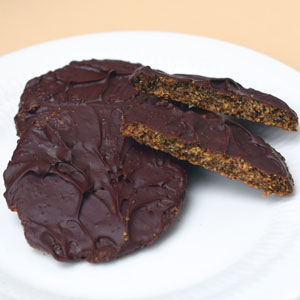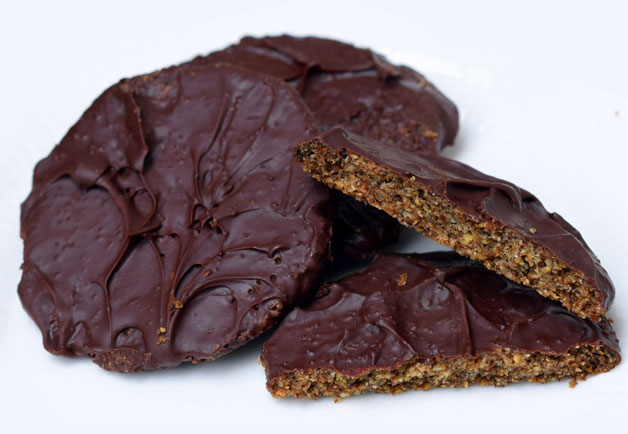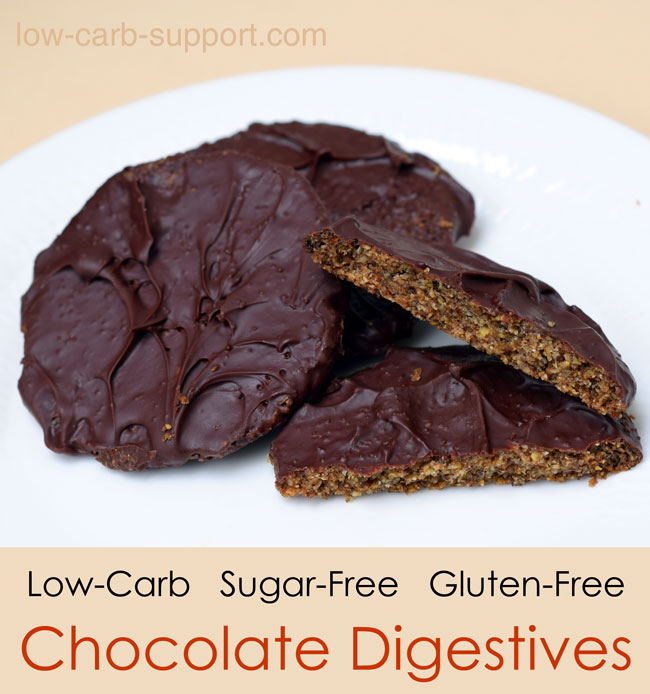 This recipe is a low-carb version of chocolate digestive biscuits.
This recipe is a low-carb version of chocolate digestive biscuits.
In Britain, digestive biscuits are a national treasure loved by everyone. If you are not from England, they are semi-sweet biscuits with fibery texture, traditionally made with wholemeal flour.
The name “digestive” dates back to 19th century, when these biscuits were believed to have antacid properties because they contain sodium bicarbonate.
They are great for dunking in your tea, and are often crumbled for use in other recipes, for example, cheesecake base.
I think they might be similar to Graham crackers in USA but I am not sure (if anyone knows, please leave a comment below and let us know).
You can get plain versions of these, and chocolate covered versions. I am of course going for the latter!
Low-carb substitute for wholemeal flour
I started looking into low-carb versions of digestive biscuits when working on my cheesecake recipes. After much experimenting, I think a mixture of ground almonds and flaxseeds creates a convincing substitute for brown flour and bran. Biscuits come out with a fibery taste and coarse texture similar to the real thing.
Sugar substitutes
I tend to use a mixture of erythritol and Stevia in most of my low-carb baking, such as Sukrin Plus or Truvia.
For this recipe, I also added a little bit of Sukrin Gold brown sugar substitute. Sukrin Gold contains a small amount (3g per 100g) of tagatose, which is a type of sugar. However, the quantity is so small that overall it adds less than 1g of net carbs to the recipe. It does caramelise nicely and so improves the texture of the biscuits. You can skip this step and use more of the erythritol/Stevia instead.
If you have a different preferred sugar substitute, use that instead, but it must be granulated – liquid drops won’t work with this recipe.
Thickeners
You will definitely need to add some sort of thickener to the recipe, otherwise, it won’t hold together and will crumble away on you. I used arrowroot. Other options could be guar gum or xanthan gum.
Chocolate glazing
These biscuits taste quite nice on their own, but you can also cover them in chocolate for a bit of extra oomph.
I prepared my glazing using Willie’s Cacao baking chocolate and coconut oil. All of these ingredients are solid at room temperature, so once cooled, they create an additional strong layer to hold the biscuits in place.
Oven temperature
Everyone’s oven is different. I have learned this the hard way.
So the temperature provided in the recipe is for guidance only – please keep checking your biscuits and take them out when they are golden before they start turning too dark.
Low-carb chocolate digestives

Prep time:40 min | Cook time:15 min | Total time:55 min
Yield: 16 biscuits
Ingredients
For the biscuits
- 1 cup (90g / 3oz) ground almonds
- 1/2 cup (60g / 2oz) ground flaxseeds
- 2 tbsp psyllium husks
- 2 tbsp Truvia or a similar granulated sweetener
- 1 tbsp Sukrin Gold brown sugar substitute
- 1 tsp baking soda
- 1 tsp arrowroot
- 1/2 tsp salt
- 90g (3oz) butter
- if required: 1-2 tbsp of milk (dairy or coconut or almond milk)
for chocolate glazing:
- 90g (3oz) sugar-free baking chocolate
- 45g (1.5oz) cacao butter
- 45g (1.5oz) coconut oil
Instructions
- Preheat oven to 190C/375F/Gas Mark 5
- Mix all the dry ingredients for the biscuits together thoroughly
- Melt the butter and add to the dry mixture
- Mix everything together with your hands (works better than using a spoon)
- If the mixture seems too dry, add 1 tbsp of dairy or milk (either dairy, or almond or coconut milk)
- Form the dough into a cylinder shape using your hands
- Wrap in clingfilm and put it in the fridge for 30 minutes or so
- Take out and unwrap your dough
- Using a very sharp knife, cut out biscuits about 3-5mm thick
- Place biscuits on a baking tray lined with baking paper
- If biscuits attempt to crumble away, reshape them with your hands
- Bake for 10-15 minutes or until golden (keep checking so that they don’t overbake)
- Cool completely before applying glazing
Optional – chocolate glazing
- Melt the chocolate, cocoa butter and coconut oil in glass bowl over simmering water (bain-marie)
- When melted, mix together thoroughly with a spoon
- If desired, add a couple of drops of liquid sweetener
- Leave the mix to cool to a semi-gooey state (like Nutella or peanut butter)
- Dip your biscuits into the chocolate mix and leave to cool further into a solid state
- If using cocoa powder, melt the butters first and then add the cacao powder to the cooled mix
Nutritional information
Per biscuit: 200 calories, 3g net carbs, 20g fat, 5g protein
Recipe by , published on
Cookbooks for low-carb baking and desserts
Do you need more low-carb baking and dessert recipes?
Check out these great cookbooks:




Julianna asked back in May if you could tell her the nutrition info for the biscuits without the chocolate covering. She didn’t get a reply. As I want to use the recipe for making cheesecake it would be very useful. Thanks
I tried these today with great excitement because they look wonderful and I love digestive biscuits. Unfortunately the recipe (which I followed to the letter) was a disaster. There was no ‘dough’ just a crumbly mess that could not be shaped into anything. In the end I pressed out biscuit shapes by pulling all the greasy crumbs together and put the baking tray in the fridge for half an hour before cooking. The resulting biscuits were flaky, crumbly and very greasy from all the butter. I didn’t bother wasting chocolate on them. I can see this could be a great base for a cheesecake ( with a bit less butter) so I have frozen the crumbly mess that I ended up with to reuse next time I make one. No idea why this ended so badly – apart from being overly greasy the taste is nice and I have now discovered flax which is a great thing.
Hi Kate
Did you try adding milk as it says at the end of the recipe? This should make a better dough if yours was too crumbly.
Hi, the recipe isn’t displaying properly in a number of browsers. I looked at the code to get the full ingredients list, and the code includes 1 tbsp [brown-sugar-sub-UK]. I can’t find out what this actually is, can you give me a pointer please? I’ve worked out the rest of the ingredients, and these are exactly what I’m looking for, so I would be grateful for some help.
Many thanks
Sukrin gold brown sugar substitute.
Just found your website and I am very excited to have some recipes for traditional British foods. My Husband is from the UK and has lost 70 lbs on a low carb diet, we have completely changed the way we cook and eat. This recipe is one I want to try immediately!
You are correct in assuming digestives are similar to graham crackers in the US, but of course in the US they are much sweeter. Graham crackers have a reputation here as only for children, because they are usually one of the first cookies (biscuits) mothers give to toddlers.
Thank you so much for the effort you put into the website and all the lovely looking recipes, they will be of great assistance when trying to recreate old family favorites and find new and different dishes to prepare! : )
Hi Janet
Thank you so much for this positive feedback, and for explaining about Graham crackers. I hope the recipe turns out well for you – please let me know how it goes.
Good luck 🙂
I’ve been looking for a good old digestive biscuit in a low carb form. Can’t wait to try these will leave some of them uncoated as I like digestive biscuits with Stilton cheese. Thanks for the recipe.
I hope they turn out well and help to fill the gap! I like your thinking about Stilton cheese – will try it out. Best of luck!
Hi Vivica,
Can you tell me how many calories and carbs a biscuit has without the chocolate glazing?
Thanks!
Arrowroot is a still a carb product. In fact, due to the lack of gluten, a protein, it has an even worse carb-to-good-stuff ratio and is more unhealthy. You could (but shouldn’t) as well just use regular flour. How about using plain old egg (yolk/white?) for holding things together? It works well in many things.
And please do not use coconut anything in chocolate. Otherwise it is not chocolate anymore. Plain old cocoa butter tastes better, is more healthy, and has better properties.
Also, given the availability of nuts, dried/roasted beans, fruit and vegetables that can be eaten without preparation (like carrots, apples, paprika, …), dried meat (like a whole ham, salami, other dried sausages), cheese, etc, I don’t really see the point of clinging to candy.
It can help, as a substitute, like methadone or e-cigs, to make reducing one’s intake easier. But the goal should be to not have an urge for any crack analogy at all.
A better solution would be, to not eat as much salt, to prevent the itch from coming up in the first place.
And to never let the energy levels go down so much too.
I don’t even want to eat any sweet stuff. Why would I, when I have much better stuff?
Yes, of course, I agree it is best to break off the addiction to sweet things completely. If you managed to do this, then bravo to you.
But unfortunately, most people do struggle with this. So if someone is on the brink of giving up the diet because of sugar cravings, it is better for them to have a low-carb dessert, than fall off the wagon and go back to real sugar.
Thanks, I do agree with you regarding arrowroot, but since only a very small amount is required, I do use it sometimes. Also agree regarding cocoa butter – but coconut oil is a more common ingredient which is easier to buy.
I love your recipes!!!!!!!!! Thank you!! You use just the sort of ingredients I like, and really appreciate your ideas. thank you
Thank you so much for your kind words, that’s really encouraging 🙂
Wow!! I’ve loved those biscuits!
Can I use Psyllium husk powder ?
Hi, yes, I am sure that would be fine! The fibre in psyllium husks binds moisture and so makes the texture of the dough a bit more supple. I hope they turn out well for you 🙂
Since it is only 1 tsp., will it make a big difference if I don’t add the arrowroot?
Hi, although it’s only a small amount, arrowroot acts as a thickener which is essential in this recipe. You can substitute it with a different thickener, such as guar gum or xanthan gum. I am afraid you can’t just leave it out though, as the dough will likely just crumble away without it, so I wouldn’t recommend it. (It’s a bit like raising agents such as baking soda – you only need 1 tsp but you can’t leave it out without destroying the texture).
I can’t wait to try this!! Digestives were my favorite cookies growing up….just dip them in tea with cream….delish!!!
Many thanks Vivica, I hope they turn out well 🙂